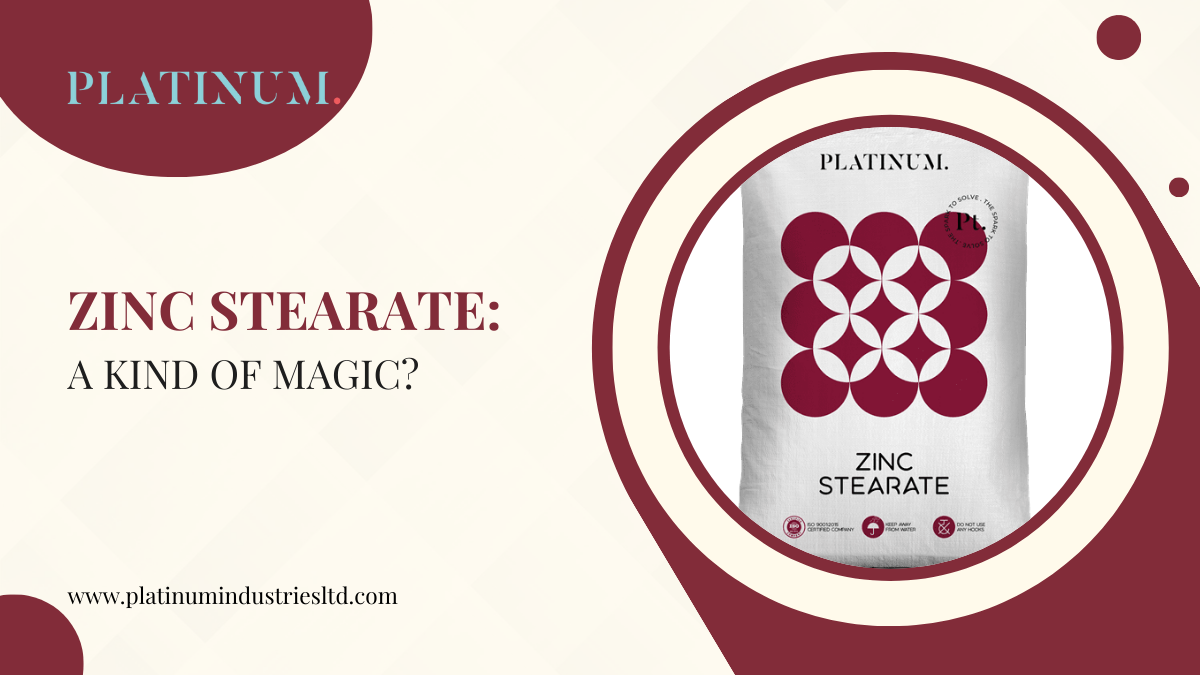In the field of industrial metal soaps and lubricants, there are multiple options for manufacturers to choose from. However, given the extensive experience of Platinum Industries within the area of these, what stands out as a lighthouse of performance and versatility among lubricants is Zinc stearate.
Let’s delve into the reasons why Zinc stearates reign supreme in various industrial applications:
1. Understanding Zinc Stearate: What is meant by Zinc stearate? – As a chemist, zinc stearates refer to the zinc salt derived from pure stearic acid, which consists of 18 carbon atoms. This holds true even for individuals lacking a chemical background. However, this description is not entirely accurate. Why? – The discrepancy lies in the definition of stearic acid. Technically, ‘stearic acid’ is sourced from renewable raw materials, such as fats and oils, notably palm oil and tallow oil, from which ‘stearic acid’ is derived. Depending on their source, these raw materials exhibit varying compositions of different fatty acids. Among them, stearic acid with 18 carbon atoms (C18) is predominant, alongside palmitic acid (C16) and, to a lesser extent, myristic acid (C14). For users, the chemically precise term would be the zinc salt of the C16-18 fatty acids. They even have different CAS numbers.
Pure Zinc stearate or Stearic acid zinc salt: CAS Number: 557-05-1 Molecular weight: 632.33 g/mol Formula: C36H70O4Zn
Technical Zinc stearate or C16-18 Fatty acid zinc salt: CAS Number: 91051-01-3 Molecular weight: not defined Formula: not defined
2. Production and Properties: Zinc stearate can be produced by several methods
- by a precipitation process in water
- by a melt process by reacting Zinc oxide with melted stearic acid at 120 to 130°C
- by fusion process by reacting Zinc oxide with stearic acid at ambient temperatures Depending on the amount and quality on stearic acid and Zinc component different a range of physical-chemical properties can be reached.
3. Heat Stability and Thermal Resistance: One of the key advantages of Zinc stearates is their remarkable heat stability and thermal resistance. Even at high temperatures, Zinc stearates maintain their colour without decomposing or degrading, ensuring consistent performance in demanding industrial environments.
4. Application: Zinc stearate demonstrate outstanding compatibility with a broad spectrum of polymers, encompassing PVC, polyethylene, polypropylene, and rubber, alongside other materials like metals and ceramics. This remarkable versatility renders Zinc stearate ideal for a myriad of applications across industries such as plastics, rubber, coatings, cosmetics, and pharmaceuticals.
| Grade | Application | %ZnO | MP/°C | %FFA | Loss on dry (105⁰C/ 60 min) | Bulk density (tapped, g/l) | pH (2% aqueous. Solution) |
| Zinc stearate- HS | In polyolefin as acid scavenger, in compounding and masterbatch as lubricant and acid scavenger, in Ca-Zn stabilisers as heat stabiliser, as release agent in automotive and rubber compounding, etc. | 13.0 – 14.5 | 118-123 | <0.5 | <0.5 | 200 – 250 | 5.5 – 6.5 |
| Zinc stearate -MB | Polyolefin, compounding and masterbatch, wood coating paints, rubber compounding, EVA compounding and EVA sheet, mould releasing, cosmetics, Ca-Zn stabilisers etc. | 12.5 – 14.0 | 118-123 | <1.0 | <1.0 | 200 – 300 | 6.0 – 8.0 |
| Zinc stearate- PIL | In Wire and Cable, PVC pipe, Construction chemicals, Ca-Zn Stabilizers etc. | 115-130 | <2.0 | <2.0 | 200 – 400 | ||
| Zinc stearate-200 | Filler compounding masterbatch, wood coating paints, rubber compounding, EVA compounding and EVA sheet, construction chemicals, cosmetics etc. | 10.0 – 11.0 | 118-123 | <1.0 | <1.0 | 250 – 350 | 6.0 – 8.0 |
| Zinc stearate-300 | Filler compounding and masterbatch, wood coating paints, rubber compounding, EVA compounding and EVA sheet, construction chemicals, cosmetics etc. | 9.5 – 10.0 | 118-123 | <1.0 | <1.0 | 300 – 350 | 6.0 – 8.0 |
| Zinc stearate-CT | Filler compounding, filler and colour masterbatch, rubber compounding, EVA compounding and EVA sheet, mould releasing etc. | 12.0 – 13.0 | 115-120 | <1.0 | <1.0 | 250 – 300 | 6.0 – 8.0 |
| Zinc stearate -PT-150 | Paints, filler masterbatch, rubber, EVA compounding etc. | 10.5 – 11.5 | 118-123 | <1.0 | <1.0 | 200 – 300 | 5.5 – 6.5 |
| Zinc stearate -PT | Polyolefin, compounding and masterbatch, wood coating paints, rubber compounding, EVA compounding and EVA sheet, mould releasing, cosmetics, Ca-Zn stabilisers etc. | 12.8 – 14.0 | 118-123 | <1.0 | <1.0 | 150 – 250 | 6.0 – 8.0 |
5. Zinc Stearate in PVC: Zinc stearate serves various functions in PVC applications. Primarily, it acts as a metal soap, replacing unstable chlorine atoms within the PVC chain, thus functioning as a stabiliser. However, its decomposition product, zinc chloride, catalyses PVC degradation, presenting a dual role. Additionally, it functions as a lubricant, akin to stearic acid. Predominantly utilised in calcium-zinc stabilisers, zinc stearate can also be combined with tin and lead stabilisers. It finds utility even in transparent applications. Nevertheless, it’s imperative to ensure its absence of free zinc oxide and/or slight acidity, with free fatty acid content below 5%.
Whether in plastics processing, rubber compounding, or cosmetics…, Zinc stearate offers a versatile and cost-effective solution that enhances processing efficiency, improves product quality, and ensures smooth operations across diverse industrial applications.
As a member of the Indian Vinyl Council, Platinum Industries, one of the best stabiliser and metal soap manufacturers, excels in producing high-grade Zinc Stearates that can add value to your industrial processes and products. Visit our website to learn more.
Platinum Industries Ltd., a member of Indian Vinyl Council (IVC)

